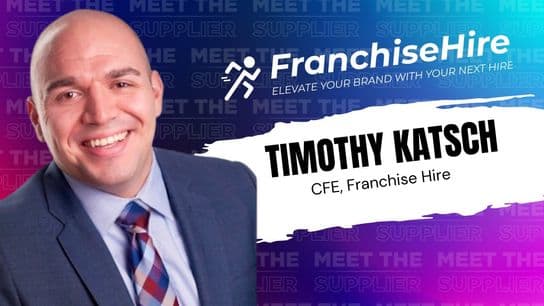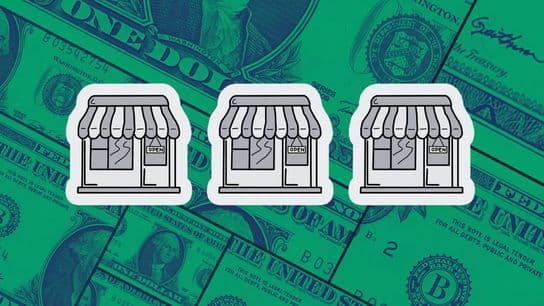What New York’s Economic Outlook Means for Franchisors
If you’re a franchisor looking to develop your business in New York, you’ll want to consider the state’s policy variables and growth rates when scaling your plans.
This month, ALEC-Laffer published their annual Economic Competitiveness Rankings, which forecasts a state’s current standing within 15 state policy variables. The report features two different rankings: Economic Outlook — a forecast based on a state’s current standing in 15 state policy variables — and Economic Performance — a retrospective measure based on a state’s performance over a 10-year period from 2008 until 2018. For the state of New York, these rankings reveal a lot about where the state economy is going and where there is opportunity for their economy to grow.
- 2020 Outlook Ranking: 50
- 2008–2018 Performance Ranking: 21
The State
The state of New York is the third-largest state economy in the United States behind California and Texas. In 2015, New York earned a GDP of $1.45 trillion and produced nearly the same amount of economic output as Canada —$1.55 trillion. That same year, New York would have ranked as the world's 11th largest economy last year as a separate country. A majority of the world’s largest corporations make their home in New York City — that paired with the mass office and residential real estate market drive much of the state’s economy. The Empire State is also driven by manufacturing, ceramics, agriculture, microchips and mining.
New York’s seemingly stable and flourishing economy hit a major roadblock with the advent of the COVID-19 pandemic, however, faring the worst of any other state in the union. According to Bankrate’s latest Housing Hardship Index — a report that considers state jobless data and mortgage delinquency rates to determine state economic conditions — found that New York’s unemployment rate and mortgage delinquency rates for the month of July rose to 15.9 percent and 8.38 percent respectively. New York City was also one of the hardest hit with cases of COVID-19, reporting more than 228,500 cases and more than 19,000 COVID-related fatalities as of August 25. As New York City residents flee the city for safety to surrounding states and New York suburbs, the city’s economy continues to shrink.
Making Sense of the Data
What does this mean for New York’s economy? To start with the Economic Performance report, the index shows that within the past 10 years, New York has been outperformed by 20 other state economies. The performance index is based broadly on a state’s performance within State Gross Domestic Product, Absolute Domestic Migration and Non-Farm Payroll Employment. The category that slowed the state down was their Absolute Domestic Migration status. New York lost 1,366,465 residents in the past decade, a stat that earned them a ranking of last among all 50 states in this category. The state’s Gross Domestic Product, however, grew 51.8 percent and earned them an impressive fourth-place ranking, and Non-Farm Payroll employment grew 10.9 percent. Though the state has seen an increase in employment and GDP, their migration numbers deeply affected their ranking.
The Economic Outlook tells another story about the New York economy. The ranking is based on a state’s current standing in 15 state policy variables. Each of these factors, ranging from sales tax burden to state minimum wage, are influenced directly by state lawmakers through the legislative process. In this overall ranking, New York is seated 50th. New York ranked considerably low across the board in each individual category, their highest ranking being 30th for both State and Remaining Tax Burdens. With livable minimum wage rates above the national average and high corporate tax rates, Alec-Laffer predicts this will negatively affect the state’s economic performance in the coming years.
The report indicates that, generally speaking, states that spend and tax less experience higher growth rates than states that spend and tax more. While this is an important finding for entrepreneurs looking to start their own business, it shouldn’t discourage them from investing in their dream franchise if they're in a market with a slower growth rate. For states like New York, Alec-Laffer’s report indicates the dollar is stretched thin in the Empire State.
When it comes to deciding where franchisors should develop their brand, it’s always important to look at the complete picture of what the region has to offer. Although in the past New York has been in the upper echelon of performance, Alec-Laffer’s index predicts the state may continue to struggle outside of the pandemic.
Franchise Growth Plans
So what should franchisors do with this information? Though most franchisors take a shotgun approach — meaning wherever a prospect franchisee inquires, the franchisor will typically entertain that marketplace — the strategy of looking at these overall policies can help them scale their business at a more efficient rate. With that said, the findings within the report should not be the deciding measure for franchisors, but they should play a role in the decision.
Lightbridge Academy*
- Current units in state: 3
- Growth capacity in state: 10
- Total jobs created at max growth capacity: 350
President and Chief Operating Officer Gigi Schweikert of early-childhood learning center Lightbridge Academy said that New York is primed and ready for growth.
“We have recently expanded into New York City and are experiencing positive results,” said Schweikert. “In spite of this challenging time, child care services are essential and bring a great deal of support to parents as they return back to work. It is important that they are confident knowing that their children are in a safe and educational environment with enhanced health and safety protocols. We have invested in state of the art air purification and filtration systems and created The Lightbridge Promise which sets the gold standard in the child care industry for cleanliness, security and peace of mind. New Yorkers are looking for quality options to give their children every advantage, and we’ll be there to help every step of the way.”
Checkers* & Rally’s
- Current units in state: 54
- Growth capacity in state: 166
- Total jobs created at max growth capacity: 4150
Robert Bhagwandat, Director of Franchise Development at Checkers & Rally’s, says the drive-thru restaurant brand is pushing through the recession to have positive growth results in 2020.
"We have a really aggressive growth agenda this year," said Bhagwandat. "We've restructured our finances and recruited capital backing to unleash that growth. As a result, our sales have been in a great position to expand, and profit is already ahead of where we were this time last year. With the new energy and talent we've recruited in the last year, we can attack the year with all due force despite the recession."
Home Clean Heroes*
- Current units in state: 0
- Growth capacity in state: 24
- Total jobs created at max growth capacity: 168
President of Home Clean Heroes Joe Delatte echoed the potential for expansion in New York state as the brand makes its way outward and upward from the success they’ve seen int eh Southeast.
“It’s no secret we aren’t the first residential cleaning business model, but we are excited to bring a fresh approach to markets in states where this particular model and franchise opportunity haven't been available,” said Delatte. “We’ve gained great traction in the Southeast so far and are looking to build out neighboring territories to existing locations. We look at income and household numbers in these markets and along with website analytics, we can zero in on markets where the need matches the want.”
TWO MEN AND A TRUCK*
- Current units in state: 6
- Growth capacity in state: 26
- Total jobs created (at max growth capacity): 650
Franchise Development Specialist at TWO MEN AND A TRUCK, Cheryl Ackley, said that their approach to development is predicated upon a variety of aspects and this process is the same in every state, including New York.
“At TWO MEN AND A TRUCK, we look at many different pieces when defining territories, specifically using data on individual household incomes, population, and ZIP codes,” said Ackley. “These reflect how the full-service moving experience will impact our communities in a positive way by moving our customers forward”.
Pool Scouts*
- Current units in state: 0
- Growth capacity in state: 25
- Total jobs created at max growth capacity: 7
Michael Wagner, President of Pool Scouts, said their development strategy starts by looking at regions that work best with their business model. Brand leadership also considers where franchisees already exist and if the brand could expand concentrically from those locations.
“We specifically look at the territory maps to see if there are additional territories to expand,” said Wagner. “Obviously, we look at the maps of pool owners by zip codes. We also look at income levels and home construction growth figures. We consider population growth too as we want to be positioned in key growth areas of the United States for years to come.”
Franchise Brands Headquartered in New York
- 1-800-FLOWERS
- 16 Handles
- Abbott's Frozen Custard
- ABC Do-Re-ME!
- Absolute Best Care
- Actor's Garage
- Apple Seeds
- Atomic Wings*
- Bear Playgrounds
- Bounce! Trampoline
- Brother Jimmy's BBQ
- Caffebene
- Calexio
- CLIX
- College Assistance Plus
- CoreLife Eatery
- Crown Trophy
- Crunch
- Dale Carnegie & Associates, Inc.
- DEI Management Group
- Desert Moon
- Doodle Bugs!
- Doorologist
- Famous Famiglia
- Four Points
- Frozen Ropes Training Centers
- Fuel Pizza
- GarageTek Inc.
- Golden Krust Caribbean Bakery, Inc.
- GradePower Learning Franchise
- Hand and Stone Massage Spa
- Hollywood Burger
- ILOVEKICKBOXING
- IM=X Pilates
- In Home Pet Services
- Junkluggers
- Kids in Sports
- Lucille Roberts Women's Fitness
- Luxury Collection Hotels & Resorts
- Mandler's The Original Sausage Company
- Mamoun's Falafel
- Maui Tacos
- Melt Inc.
- Minuteman Press International, Inc.
- Nathan's Famous
- Nite Time Décor
- OneClick Cleaners
- Papaya King
- Pets Warehouse
- Planet Wings
- Rapid Realty
- RESCUECOM
- SHIELD Security Systems
- Starwood Hotels
- Sterling Optical
- Swirls and Twirls
- The Eco Laundry Company
- The Halal Guys
- The Hummus & Pita Co.
- The Luxury Collection
- The Patch Boys
- Tilden Car Care Centers
- Total Nutrition
- TruFoods
- Twin Donut
- Vehicle Tracking Solutions
- Virgola Oysters & Italian Wine Bar
- W Hotels Worldwide
- Wall Street Deli
- Westin Hotels
- Weight Watchers
- Woops!
- White Glove Placement
*This brand is a paid partner of 1851 Franchise. For more information on paid partnerships please click here.









